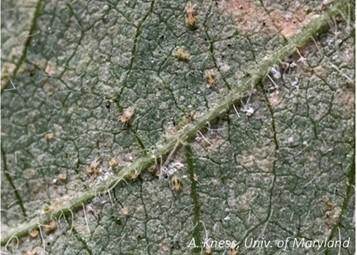August IPM Insect Scouting Tips
Soybean
Continue to scout for stink bugs, dectes stem borer, and defoliators (bean leaf beetle, Japanese beetle, grasshoppers, and caterpillars). Control may be needed if there is 15% defoliation from bloom through pod fill. Chemical control is not recommended for dectes stem borer since it would require multiple applications to reduce larval infestations, which is not economical. If a high number of adults are found, harvesting that field as soon as it matures will reduce losses associated with lodged plants.
With the upcoming hot weather, there is an increased chance of spider mite outbreaks in vegetable and soybean fields (Fig 1). Scout by using a hand lens to examine mid to upper canopy leaflets on two plants in twenty locations along the edges of the field. Consider treating if 10 % of plants have heavy stippling feeding damage on ⅓ of their mid and lower leaves.
The next flight of corn earworm (CEW) will be taking place soon. Bean fields with open canopies (wide rows), are drought-stressed, or have recently had an insecticide applied are at higher risk for CEW. CEW larvae can feed on flowers without impacting yields. NC State has a good economic threshold calculator to assist with management decisions: https://www.ces.ncsu.edu/wp-content/uploads/2017/08/CEW-calculator-v0.006.html.
Field Corn
Check for stink bugs around the edges. The threshold is 1 stink bug per 2 plants from pollen shed to blister stage. Treatment is not recommended past the blister stage.
Sorghum
Sugarcane aphids typically show up in fields in late July and August. Check the underside of leaves for insects. Honeydew will turn leaves shiny and is an easy-to-see indicator that aphids are present. Sugarcane aphids are light yellow with black cornicles, antennae, and feet. Thresholds depend on the plant growth stage; at boot to milk, thresholds are 50 aphids per leaf on 25 – 30% of plants. There is documented resistance to resistance to pyrethroids.
This article appears on August 2021, Volume 12, Issue 5 of the Agronomy news.
